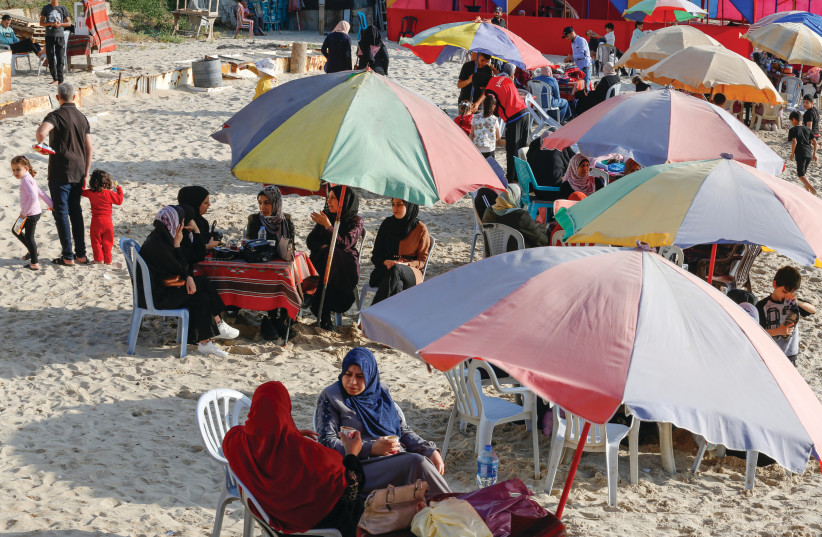‘No one is going to tune in to two nights of Armageddon,” predicted director Nicholas Meyer before creating The Day After, a landmark TV film about a nuclear war between NATO and the Warsaw Pact.
Meyer’s pessimism about a miniseries was never tested – the film was aired in one installment on November 20, 1983 – but there is no arguing that everyone tuned in: more than 100 million Americans in nearly 40 million homes. This is the ominous origin of the suddenly popular phrase “Gaza’s day after.”
The bad news is that the cinematic “day after” was about the irreparable destruction in which a gloveless exchange of atomic blows would surely result: sterilized farmlands, incinerated people, and irradiated survivors inhabiting a scorched Earth.
The good news is that the warring in Gaza is not Armageddon. Yes, it’s part of a regional war with fronts from Iraq to Yemen, and a global war between jihadism and the rest of mankind.
Still, this mayhem’s Gazan segment is confined to a patch of land the size of Manhattan, and a population smaller than Kuwait’s. Gaza’s catastrophe can be brought to an end if all the governments Hamas threatens by its very existence launch the following plan.

GAZA’S REINVENTION should be based on three understandings. The first is that jihadism is bad; not only for Gaza, and not only for the non-Muslim world, but also for the rule of every Arab government that believes in tolerance.
The second consensus should be that Gaza’s schools must be overhauled; that Gaza would not have become a heap of rubble but for a bigoted educational system and hateful propaganda drive that would have made Joseph Goebbels happy.
The third consensus must be that Gaza needs a life, an engine of livelihood that will render its current system of handouts irrelevant – and its two sponsors, UNRWA and Qatar, obsolete.
The prospective parties to the new Gaza consensus are well known: all the Arab governments, from Morocco to Bahrain, which are threatened by religious fanaticism. Underpinning this religious attitude will be a geopolitical understanding that the Middle East’s key troublemaker is Iran, whose leaders inspire and supply irredentism in multiple lands.
The task must be shared
Having agreed on all these, the question will be who should do what in order to reboot the Gaza Strip. And the answer is that everyone will be in charge of something, according to this outline:
THE GULF kingdoms, the US, and Israel will give money; Egypt will give economic space; Jordan will create a police force; and a pan-Arab board headed by Egypt and joined by the Palestinian Authority will build a local government. Once built, and after running for an agreed period of time to everyone’s satisfaction, this government will be gradually transferred to the Palestinian Authority.
The economy will be built in four different directions: construction, industry, farming, and tourism. Reconstruction will follow a master plan that will span everything – from neighborhoods, roads, sewage, industrial zones, and commercial quarters to power stations, water treatment, coastal development, transportation projects, and parks.
The massive reconstruction that will comprise all of this will itself generate thousands of jobs. Obviously, all construction will have to be conducted under close, American-led international supervision, to ensure that no tunnel, armory, missile launcher or any other military tool is built.
Meanwhile, industrial development will involve Egyptian leadership and gain.
The coastal strip along the northern Sinai from Rafah westward is nearly empty, a splendid shoreline that can be turned into a Riviera of hotels, resorts, and factories. That land can shoulder thousands of businesses in both tourism and industry, without one Gazan actually residing there.
Thousands of Gazans can commute daily to work in northern Sinai. In due course, a railway can be built between Gaza and Port Said, at the Suez Canal’s mouth. Egypt will thus not become the home of even one displaced Gazan. It will, however, make billions of dollars in corporate taxes and commuter tolls.
The project should be led by Egypt because it’s the biggest Arab country, and also the one closest to Gaza. Having said this, the project’s managing board should include other Arab governments, as well as the Palestinian Authority. Israel cannot be a formal part of this body, both in terms of its purpose – it must win Gazans’ trust – and in terms of Israel’s interest, which is to avoid governing Palestinians.
Even so, Israel can, and should, be a significant contributor to Gaza’s rehabilitation, which it can do by leading the construction of a Gaza seaport, in both planning and financing.
This is what should happen economically and politically. Finally, the most challenging project, the reinvention of Gaza’s schools, should be led by the United Arab Emirates, which in recent years has emerged as a Middle Eastern paragon of religious tolerance and political prudence.
With Emirati leadership, Gazan children whose older siblings were indoctrinated to hate, kill, and die may in upcoming years be taught to dialogue, enterprise, and appreciate life.
Yes, Gaza is devastated, but it’s not a nuclear wasteland. One of the oldest, continuously inhabited towns in the world, it has been leveled in the past, most memorably by Alexander the Great, who razed Gaza after its Persian governor, Batis, chose to resist the Macedonian march from Europe to Africa through Asia’s coast.
Gaza was leveled, but it was later rebuilt and became a peaceful, prosperous, cosmopolitan, and tolerant town featuring a seaport that shipped cinnamon, ginger, pepper, and cloves from the Arabian Desert to European shores.
That legacy, the inversion of today’s Gaza of death, is what Gaza’s day after should be all about: a Gaza of life.
www.MiddleIsrael.net
The writer, a Hartman Institute fellow, is the author of the bestselling Mitzad Ha’ivelet Ha’yehudi (The Jewish March of Folly, Yediot Sefarim, 2019), a revisionist history of the Jewish people’s political leadership.
